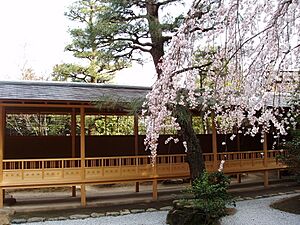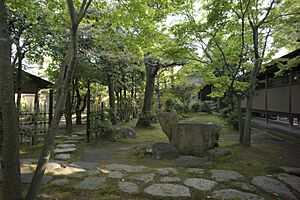Ueda Sōko-ryū facts for kids
The Ueda Sōko-ryū (上田宗箇流) is a special way of practicing the Japanese tea ceremony. It started a long time ago with the samurai (warrior class) in feudal Japan. People often call it the Ueda Sōko Ryū or just Ueda Ryū. The word Ryū means "Tradition" or "School" in Japanese.
This tradition is named after its founder, Ueda Sōko, who was a powerful warlord during the Sengoku period. The rules, manners, and values of the samurai are a big part of how the tea ceremony is done in this school. This tradition has been passed down for over 400 years without stopping!
Contents
Who Was Ueda Sōko?
Ueda Sōko first worked for a lord named Niwa Nagahide. Later, a very powerful leader named Toyotomi Hideyoshi chose Ueda Sōko to be one of his helpers and a daimyō (a powerful Japanese lord).
Ueda Sōko learned the tea ceremony from two famous teachers: Sen no Rikyū and Furuta Oribe. After learning from them, he created his own style of tea ceremony. This style was strongly shaped by the values and customs of the samurai from the Sengoku period (mid-1400s to early 1600s). Since Ueda Sōko's time, the Ueda School has been led by 16 generations of family heads, following a system called iemoto. The current head is Ueda Sōkei.
Ueda Sōko was also a famous garden designer during the Momoyama period (1568–1603). He designed many beautiful gardens that are still famous in Japan today. Some of these include Shukkei-en in Hiroshima, Tokushima Castle Garden, Nagoya Castle Garden, and Wakayama Castle gardens.
After a big battle called the Siege of Osaka (1614–1615), the Toyotomi family lost their power. In 1619, Ueda Sōko moved to Hiroshima with his new lord, Asano Nagaakira. Asano became the daimyō of the Geishū Domain (which is now Hiroshima Prefecture). Ueda Sōko was given land in western Hiroshima that produced 17,000 koku of rice (which is about 2,788 tons!). He became Asano's main helper for the Geishū Domain.
The Ueda family continued to govern their land in western Hiroshima for many generations. Ueda Sōko's tea ceremony style was passed down through his family and is still very active today.
History of the Ueda Sōko Tradition
In 1619, Asano Nagaakira became the daimyō of the Geishū Domain. This meant he was the lord of Aki Province and half of Bingo Province, which was a lot of land (about 426,500 koku of rice). Ueda Sōko went to Geishū to serve Lord Asano. Sōko was given land and became Asano's Chief Retainer.
Sōko chose two families, the Nomura and Nakamura families, to help him. He gave them land and asked them to teach and perform his style of tea ceremony for the Asano and Ueda families. This role was called "Chaji Azukari," meaning "holders of the tea ceremony teachings."
During the middle of the Edo Period, more and more people started practicing the tea ceremony. Other tea traditions began to use the Iemoto system, where the head of the family leads the school. Later, a system for grading students, called the Sōden grading system, was also created.
The Ueda Sōko Tradition became popular not just with samurai but also with regular townspeople in the Kansai region and Chu-Shikoku regions. This meant the school needed a more formal way to teach. So, in 1839, the Nomura and Nakamura families created a new Sōden System. This system made it possible to teach Ueda Sōko's tea style in a clear, step-by-step way through many generations. The highest level of teaching, called Shin Daisu, was kept within the Ueda Family.
After the Meiji Restoration, the old system of domains in Japan ended. Many tea masters who worked for the daimyōs lost their jobs. The 12th Grandmaster, Ueda Yasuatsu, led the Ueda Family during this big change. In 1870, he became a Buddhist monk and focused on the tea ceremony, just like Ueda Sōko did. He kept the Nomura and Nakamura families as "Chaji Azukari" until 1955.
Today, the Ueda Sōko Tradition continues as a special example of "Warrior Tea." This style of tea ceremony was created during the Momoyama Period (1568–1598), a time when warlords faced danger every day. Because of this, the tea ceremony of the samurai aimed to bring peace to the mind. The Ueda Tradition still helps people "learn their true heart through the Way of Tea."
What Makes Ueda Sōko Tea Ceremony Special?
The Ueda Sōko Tradition of tea ceremony (chanoyu) has some unique features:
- It's a "Warrior Class" tea school that has continued without interruption from the Momoyama Period (around 1573–1603) until today.
- It shows the special artistic style of Ueda Sōko. This style combines two ideas:
* Rikyū's idea of calm beauty, which comes from small movements in a quiet, shadowy world. * Oribe's idea of freedom, which comes from light, open spaces, and flowing shapes. Ueda Sōko mixed these two ideas to create an elegant and dignified beauty called "utsukushiki."
- It's the only school that has rebuilt its main headquarters to look like an Edo Period samurai home. It has a special tearoom complex called ‘Wafūdō’ and a reception building. The school also keeps many old tea tools, artworks, and ancient texts that are very important to the history of the tea ceremony.
- It is known for its graceful and beautiful style. The movements in the tea preparing ceremony (temae) are dignified and elegant. This is done by making movements in straight lines and avoiding any unnecessary actions. The school also focuses on balancing yin and yang in the person performing the ceremony. This often means men have a stronger style, and women have a softer style, which was common in samurai culture of the Momoyama Period.
More specifically, here are some details:
- The tea preparing ceremonies (temae) are different for men and women.
- The way of bowing is different for men and women.
- The purifying cloth (fukusa) is worn on the right side of the obi (a sash). This is because a samurai's sword was on the left side, and that side was kept free out of respect for the sword, in case they needed to quickly grab it for battle.
- The way the bamboo ladle (hishaku) and purifying cloth (fukusa) are handled is very special in the Ueda Tradition. For example, men handle the ladle as if they are riding a horse in battle, putting away their sword, and drawing water as if handling an arrow.
- The movements in the tea preparing ceremony (temae) are made in straight lines and flow with your breath. Doing the ceremony in harmony with your breath helps refresh your spirit. The focus is on releasing your breath and energy "from inside to out."
Wabi-cha and Warrior Tea
Wabi-cha is a style of tea ceremony that became popular in the Momoyama period. It focuses on using small tea rooms (about four and a half mats or smaller) and simple, rustic tea tools in a calm atmosphere. This style emphasizes the idea of wabi, which is about finding beauty in simplicity and imperfection. The Ueda Ryū values wabi-cha and its aesthetics.
Another important part of the Ueda Ryū is that it has continued as a unique tradition called buke-cha, or 'warrior tea'. These are tea traditions that started and grew within the samurai class. So, warrior tea traditions are full of samurai culture and customs. The Ueda School is now very well-known as a leading example of warrior tea.
Tea Drinking in the Ueda Sōko Tradition
The Ueda Tradition is a samurai tea school that began in the Momoyama period (1568–1598). The warlords of this time lived in a very dangerous world where death was a daily fear. Because of this, the tea ceremony of the Momoyama period samurai aimed to bring peace to the mind and strength to the spirit.
The Temae of the Ueda Sōko Tradition
The temae (tea preparing ceremony) of the Ueda Tradition is often described as elegant and beautiful. There are two main reasons for this:
First, the actions in the temae are done in straight lines, and all unnecessary movements are removed. This creates a clean, dignified look that also makes the person performing the ceremony feel refreshed.
Second, the actions are performed in a way that matches the "in-to-out" flow of your breath (for example, when cleaning the whisk, turning the tea bowl, or whisking the tea). With practice, you can perform the temae in a natural, flowing way that is in harmony with your breathing. The idea is to move with an "unshakeable core expanding out," which is a basic principle of strong, confident action. The Ueda Tradition's tea ceremony is built on this idea.
These two things – (1) clean, straight actions that refresh you, and (2) strong actions done in harmony with your breath – make the temae of the Ueda Tradition look very dignified and beautiful.
Utensils and the Body
In the Ueda Tradition, a key goal is for the tea tools and your body to work together perfectly. This means you don't slouch or just move your arms when handling objects. Instead, you use your whole body, moving from your center.
Objects are held with a calm and steady posture: at navel height, about 3 cm behind your knees, and with enough space under your arms (like an egg). You hold objects firmly with your thumb and middle finger, and your index finger touches lightly. You don't just use your arms to put objects down; your whole body helps. Your eyes also focus on the tool you are using at that exact moment. Harmony is achieved when the tool, body, arms, breath, and eyes all move together.
Ueda Sōko's Teacher, Furuta Oribe
Furuta Oribe (古田 織部) (around 1544 – July 6, 1615) is one of the most famous tea masters in history, second only to his teacher, Sen Rikyu. Unlike Rikyu, who was a merchant, Oribe was a samurai. He helped create a style of tea ceremony that fit the values of the samurai class, known as buke-cha (warrior tea). Oribe was a daimyō and served powerful lords like Oda Nobunaga, Toyotomi Hideyoshi, and later the Tokugawa clan.
After Rikyu's death, Oribe became the most important tea master in Japan. He even taught the tea ceremony to the second Tokugawa shōgun, Tokugawa Hidetada. Other famous students included Kobori Enshū and Ueda Sōko.
The popular Oribe-ware style of pottery is named after him, showing his artistic influence. He also designed a type of stone lantern for tea gardens, called Oribe-dōrō.
During a conflict in 1615, Oribe was suspected of being disloyal to the Tokugawa. He and his son died. Since Oribe's family ended, his tea legacy was continued by Ueda Sōko, who had studied with Oribe for 24 years. Ueda Sōko later settled in Hiroshima and developed his tea style, which was greatly influenced by Oribe.
Rebuilding the Ueda Clan Home in Hiroshima
In 1619, the Tokugawa Shogunate gave Asano Nagaakira control of the Geishū Domain and part of the Bingo Domain. Ueda Sōko moved to Hiroshima with Nagaakira as a special guest. Sōko was given land and a home on the grounds of Hiroshima Castle. There, he built a reception hall and his tea house called ‘Wafūdō’ (和風堂). This remained the official home of the Ueda Clan until the samurai class lost their feudal homes during the Meiji Restoration.
The Ueda Clan left their home at Hiroshima Castle in 1871 after 250 years. They eventually settled in the Furue district of Hiroshima. In 1982, Wafūdō was rebuilt with outer and inner tea gardens and a tea house called Enshō. This new Wafūdō was based on the original one Sōko built at Hiroshima Castle. Later, in 2008, the reception hall, a bridge connecting it to Wafūdō, and other rooms were also rebuilt to be as similar as possible to Sōko's original design.
Thanks to this work, the Ueda Clan's home was recreated at the current location of the Ueda Tradition, 137 years after it was lost at Hiroshima Castle. Central Hiroshima city was destroyed by the atomic bombing in 1945. Luckily, the Ueda Clan's location in Furue, in the western part of Hiroshima, meant that their historical artworks and writings survived the disaster. With these records, it was possible to rebuild the original Ueda Clan residence.
Some of Sōko's original stone purifying basins, garden lanterns, and garden stones were passed down through the Ueda Clan. These old stone pieces are now in the current gardens of Wafūdō, connecting the modern building to its ancient past.
Family Tree of the Ueda Sōko Ryū
The Ueda Family got its name from the city of Ueda in Shinano Province (now Nagano Prefecture). They chose this name after coming from the Ogasawara clan. The Ogasawara Clan were samurai who came from a famous family called the Seiwa Genji. Ueda Sōko's grandfather and father were both famous warriors who served Niwa Nagahide during a time of war.
In 1619, Ueda Sōko came to Hiroshima to serve Asano Nagaakira. Sōko had two sons, Shigehide and Shigemasa. Soon after settling in Hiroshima, Sōko's oldest son, Shigehide, had to live in Edo Castle as a kind of hostage to the Tokugawa shogunate. In 1632, since his oldest son was still in Edo, Sōko's second son, Shigemasa, became his successor. Shigemasa's family kept their land and served as Chief Retainers for the Hiroshima Domain.
The Meiji Restoration happened during the time of the 12th generation head, Ueda Yasuatsu (also known as Ueda Jyōō). The current head of the Ueda Family, Ueda Sōkei, is the 16th generation after Ueda Sōko.
Generations of the Ueda Clan
- Ueda Mondonokami Shigeyasu (Sōko) (1563–1650) - The founder.
- Ueda Bizennokami Shigemasa (1607–1650) - Sōko's second son, became head when his older brother was in Edo.
- Ueda Mondonosuke Shigetsugu (1638–1689) - Shigemasa's son.
- Ueda Mondo Shigenobu (Sawamizu) (1662–1724) - Shigetsugu's son, skilled in tea ceremony and ceramics.
- Ueda Mondo Yoshiyuki (1694–1725) - Adopted into the family.
- Ueda Mondo Yoshiyori (1715–1736) - Rebuilt the Hiroshima Wafūdo.
- Ueda Mondo Yoshinobu (1702–1743) - Adopted into the family.
- Ueda Minbu Yoshitaka (?-1755) - Died young at 19.
- Ueda Mondo Yasutora (?-1802) - Established an education forum for vassals.
- Ueda Mondo Yasutsugu (1777–1820) - Interested in literature and poetry.
- Ueda Mondo Yasutoki (Shōtō) (1807–1856) - Famous calligrapher and made tea ceramics.
- Ueda Mondo Yasuatsu (Jyōō) (1820–1888) - Led the family during the Meiji Restoration, focused on tea and poetry.
- Ueda Shōgoi Danshaku Yasukyo (1849–1907) - Studied many arts and Western learning.
- Ueda Shōsani Danshaku Muneo (Sōō) (1883–1961) - Skilled calligrapher and painter.
- Ueda Shōgoi Motoshige (Sōgen) (?-1994) - Restored Wafūdō.
- Ueda Sōkei (1945-) - Current head, rebuilt the original Ueda Clan residence.
Grand Retainers of the Ueda Clan's Tea Ceremony
The special way of teaching the Ueda Clan's tea ceremony was created by Ueda Sōko himself. Even though Ueda Sōko and his family were dedicated to tea, they didn't teach people directly. Instead, they gave the job of teaching the school to two special families.
In 1632, a man named Nomura Yahee no Jyō Moriyasu came to Hiroshima to learn tea from Ueda Sōko. Moriyasu was given land and later became the first Grand Retainer of Ueda Sōko's tea ceremony.
One of Nomura Kyūmu's students was Nakamura Masachika-Chigen. He also served Sōko and was given land. After Kyūmu died, Chigen became the first Grand Retainer from the Nakamura family. So, Ueda Sōko entrusted the teaching of his tea style to these two families: the Nomura and Nakamura.
These two families were hired by the Ueda clan to pass down the Ueda tradition of tea ceremony through many generations. It is thanks to these Grand Retainers that the Ueda tradition has been faithfully passed down, without interruption, from Ueda Sōko to today.
After the death of the 15th generation Nakamura Kaidō in 1906, both the Nakamura and Nomura families no longer had successors. So, the role of 16th generation Grand Retainer was given to their best student, Mukai Chikkadō. Kakei Seidō then followed Chikkadō as the 17th generation Grand Retainer until his death in 1955. Seidō was the last of the Grand Retainers of Ueda Sōko's tea ceremony. With his death, the system of having these special families teach the Ueda tradition came to an end.
 In Spanish: Ueda Sōko-ryū para niños
In Spanish: Ueda Sōko-ryū para niños




